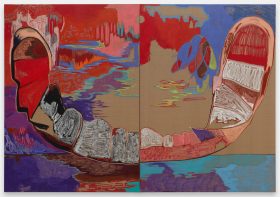The world wide web’s potential as an information superhighway for the masses in generating discussion, debate and participation challenges the singular authoritarian status held by the powers of the state and corporate economy. In the art world, the rhizomic nature of the web has enabled any artist with a decent sized modem access to an audience without the need for a middle man. Is this trend revolutionizing the art world? How is virtual space transforming the production and distribution of art?
For artists the possibility of reaching a global audience, unrestricted by art galleries or a middle-man is liberating. According to Jon Ippolito, an artist and curator at the Guggenheim Museum, the online art community (which has developed largely outside the reach of established galleries and dealers) has surprised sellers and curators with its popularity and global following. In many cases, more people are surfing respected Internet art sites than physically visiting galleries. Where previously the authorities of art were the domain of dealers and art galleries, the Internet has enabled artists to empower themselves and reap the financial rewards.
One such artist who has generated a loyal fan base as well as inspired other “artists/bloggers” is Duane Keiser. Keiser paints every day and posts an image of his postcard-size oil paintings on his daily blog DuaneKeiser.blogspot.com. As word of mouth gradually spread online, Keiser’s initial asking price of $100 for each painting increased first two, then four hundred percent. Keiser says that, among other advantages, he enjoys the direct connection between artist and buyer – something often sidelined, or deliberately avoided in the real-world gallery circuit.
Another successful artist is Michel Leah Keck, also known as The Raw Artist, who has netted a jaw-dropping $25,000 a month from the sales of her artwork on eBay.
Hosting your own website can be expensive, and this factor may have put an end to budding exhibitionists dreams of bypassing the art establishment. But this too is changing. Web galleries of every stripe are popping up to do the job for you, from Art.Net, a non-commercial web space hosted by an artist collective, to major players, such as Charles Saatchi’s recently launched Your Gallery.
Unveiled in April 2006, Your Gallery is a groundbreaker. The virtual display case does not have a curatorial policy or charge a commission on any sale of artwork, hence its popularity amongst unknown and emerging artists. Furthermore, its popularity also extends to collectors, curators and the world’s leading art dealers, who trawl the site as a guide to talent that wouldn’t normally make the radar of the establishment.
The availability of art on the Internet and associated artist autonomy excites New York collector and corporate attorney Gregory Peterson. “Now artists can sell directly to consumers, using blogs or auction sites at prices more affordable to would-be collectors,” he told USA Today. “The result: More people are making a living as artists, more people are buying art, and more art is selling at a wider spectrum of prices.”
Nevertheless, the net art boom has its critics, many who feel over-romanticizing artist success is a real danger. Anne Lahumière, President of the French Committee of Art Galleries believes you just can’t do things without some one-on-one contact. “The physical contact with a work of art is indispensable,” she says. “Even with catalogues, I’ve already had bad surprises, such as holes in paintings that weren’t visible in the photo. The Internet will only attract those looking for a $200 piece of junk they can hang on their wall somewhere back in Michigan.”
Another wary proponent is Tanner Tuttle, co-owner of Period Gallery. While Tuttle hosts an independent web gallery space, he cautions artists and consumers about keeping their options open. “There’s so many companies out there that say ‘Hey, you put your art online, it will be like eBay and people will buy it up in a snap.’ That’s really not realistic from what we’ve seen over the past couple years,” he told Business Week.
According to Doug McClennan, editor of Artsjournal.com, it’s undeniable that virtual space is making for more active participation in culture and cultural consumption. “You can look at this information revolution, we could call it, as simply a phenomenon of better distribution and better ways to use things,” he says, “but you also have to look at it, I think, as a redefinition of artist and audience. Sometimes the audience is the artist. Sometimes the artist is the audience. You’re looking for ways to have an impact on one another.”




